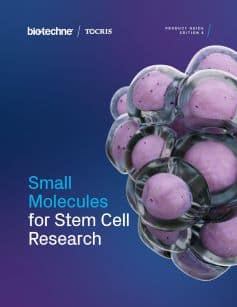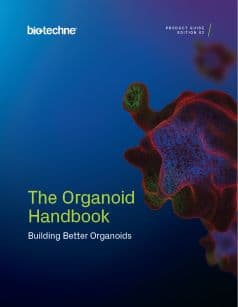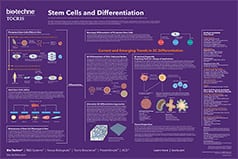Organoids
Organoids are 3D tissue/organ models derived from stem cells and other supporting co-cultured cells such as epithelial cells. When cultivated appropriately, the differentiating stem cells have the ability to self-organize into organ-like tissue and exhibit some organ function. Organoids make stable, physiologically relevant models and are amenable to long-term cultivation. View all organoid resources available from Bio-Techne.
Kits |
|
|---|---|
| Cat. No. | 产品名称/活性 |
| 7991 | CEPT Cocktail Kit |
| Cell culture supplement for improving stem cell survival | |
| 7390 | Tissue Clearing Pro-Organoid |
| 3D cell culture clearing reagent kit | |
Libraries |
|
| Cat. No. | 产品名称/活性 |
| 7340 | Tocriscreen Stem Cell Library |
| A library of 120 stem cell compounds (100 μL 10 mM DMSO solutions) to explore stem cell reprogramming, differentiation, proliferation and signaling | |
Other |
|
| Cat. No. | 产品名称/活性 |
| 2939 | A 83-01 |
| Commonly used as 3D growth matrix component and additive for long-term organoid growth | |
| 5758 | AGN 193109 |
| Promotes the differentiation from mouse embryonic stem cells into paraxial mesoderm, used for retinal and kidney organoids | |
| 0760 | AM 580 |
| Promotes the reprogramming of somatic cells to induced pluripotent stem cells, used for kidney organoids | |
| 4055 | L-Ascorbic acid |
| Antioxidant used for neuronal and pancreatic organoids generation | |
| 2837 | BDNF (human) |
| Improves the functional maturation of neurons in the neuronal organoids | |
| 4423 | CHIR 99021 |
| Commonly used in multiple stages of organoid generation | |
| 7163 | Chroman 1 |
| Highly potent and selective ROCK 2 inhibitor; improves cell survival after cryogenesis | |
| 6476 | Compound E |
| γ-secretase and notch patchway inhibitor, for neuronal and pancreatic organoids | |
| 2634 | DAPT |
| 3D Growth matrix component and component of cerebral organoid differentiation media | |
| 4489 | DBZ |
| Improves efficiency of iPSC generation and production of iPSCs from mouse and human keratinocytes, used for neuronal, gastrointestinal organoids | |
| 6873 | DC 271 |
| Fluorescent retinoic acid analog; solvochromatic probe | |
| 1126 | Dexamethasone |
| Used in the generation of liver organoids. | |
| 3093 | Dorsomorphin dihydrochloride |
| Promotes cardiomyogenesis in mouse ESCs in vitro and promotes neural differentiation of hPSCs as part of a chemical cocktail, used for kidney, neuronal and glial organoids | |
| 7194 | Erlotinib Hydrochloride |
| Potent, selective EGFR tyrosine kinase inhibitor; promotes differentiation of urothelial organoids | |
| 1099 | Forskolin |
| 3D Growth matrix component used in liver organoid generation | |
| 6956 | Galunisertib |
| ALK4 and ALK5 (TGFβRI) inhibitor; component of growth media for urothelial organoids | |
| 3006 | Gastrin I (human) |
| Used in the culture of stomach and liver organoids; CCK2 receptor agonist | |
| 2812 | Heparin sodium salt |
| Used in protocol to generate kidney organoids | |
| 3173 | HEPES |
| Multipurpose HEPES buffer; used in 3D cell culture | |
| 3000 | Iressa |
| EGFR tyrosine kinase inhibitor, used in the generation of lung organoids | |
| 4439 | ISX 9 |
| Increases expression of neurogenic differentiation 1 transcription factor, used in the generation of neuronal, gastrointestinal, pancreatic organoids | |
| 3533 | IWP 2 |
| Component of heart organoid differentiation media | |
| 5214 | IWP 4 |
| Component of heart organoid differentiation media | |
| 3532 | endo-IWR 1 |
| Component of neocortex differentiation media | |
| 6053 | LDN 193189 dihydrochloride |
| Component of brain organoid differentiation media | |
| 8150 | LDN 193189 in solution |
| Sterile-filtered 10 mM solution of LDN 193189 pre-dissolved in water | |
| 7874 | N-Acetylcysteine |
| Commonly used in multiple stages of organoid generation; also GSH precursor; antioxidant | |
| 4106 | Nicotinamide |
| Commonly used as 3D growth matrix components and additive for long-term growth | |
| 4192 | PD 0325901 |
| Base media component used in ear organoid generation | |
| 4786 | PD 0332991 isethionate |
| Used in the generation of neuronal, urothelial organoids | |
| 7739 | Polyamine Supplement x1000 (lyophilized) |
| Media supplement to boost cell growth; used as component of CEPT cocktail to enhance stem cell viability | |
| 2296 | Prostaglandin E2 |
| 3D Growth matrix component used in liver and prostate organoid generation | |
| 3742 | RepSox |
| Enhances the efficiency of cellular reprogramming; replaces Sox2 by inducing Nanog expression, for pancreatic organoids generation | |
| 0695 | Retinoic acid |
| 3D Growth matrix component used in kidney organoid generation; also a component of brain organoid differentiation media | |
| 5325 | Rosiglitazone |
| Promotes differentiation of urothelial organoids; potent and selective PPARγ agonist | |
| 1974 | SANT-1 |
| Promotes beta cell differentiation from human embryonic stem cells for pancreatic organoids | |
| 1264 | SB 202190 |
| 3D Growth matrix component and additive for long term growth; also component of gastric organoid culture media | |
| 1614 | SB 431542 |
| 3D Growth matrix component; also component of brain and blood vessel organoid differentiation media | |
| 1285 | Staurosporine |
| Enhances efficiency of lentiviral transduction of human hematopoietic stem and progenitor cells, induces dopaminergic axonal outgrowth in vitro, used for neuronal and retinal organoids | |
| 3845 | Thiazovivin |
| Enhances the efficiency of fibroblast reprogramming to generate iPSCs, improves the survival of hESCs, increases cell adhesion and significantly improves direct reprogramming efficiency. | |
| 7917 | TM2 TEAD inhibitor |
| YAP-dependent liver organoid growth inhibitor; potent inhibitor of TEAD mediated Hippo/Yap signalling | |
| 4855 | WIKI4 |
| Wnt/β-catenin signaling inhibitor, used for pancreatic, neuronal and cardiac organoids | |
| 5148 | Wnt-C59 |
| Component of pancreatic, cardiac and neuronal organoids differentiation media | |
| 3748 | XAV 939 |
| Used in neuronal differentiation protocols; lung and inner ear organoids generation | |
| 1254 | Y-27632 dihydrochloride |
| Commonly used as 3D growth matrix component; also a component of brain organoid differentiation media | |
| 7000 | Y-27632 in solution |
| Sterile-filtered 10 mM solution of Y-27632 pre-dissolved in water | |
Organoids are cultured from adult stem cells or from cells differentiated from pluripotent stem cells, self-organized through cell sorting (see image below). Different types of cells arrange themselves based on the distinct expression profiles of cellular adhesion molecules and spatially restricted lineage commitment. Spatially constraining cells in tissue or artificial conditions promotes further differentiation of stem cells and is crucial in the generation of organoids. In the laboratory, lineage commitment is most commonly encouraged using the biological scaffolds derived from Engelbreth-Holm-Swarm (EHS) mouse sarcoma cells (i.e. Cultrex® Basement Membrane Extracts). These scaffolds provide environmental cues such as growth factors, which encourage cells to attach and form organoid structures.
Small molecules are increasingly being used to grow and maintain organoids, due to their ease of use, efficacy and specificity. In addition, they are chemically defined with low lot-to-lot variability and high purity.
Stages of organoid generation

Figure 1 Image shows the three main stages of organoid genesis: differentiation, cell sorting and spatially restricted lineage commitment.
Organoids have three defining characteristics:- They consist of multiple cell types found in the organ being modeled
- They must exhibit some of the functionality of the organ
- Organoid cells are organized in a similar manner to the organ
Organoid Uses
Human iPSCs have been derived from patients with diseases such as cardiomyopathy and Parkinson's disease and cultivated into organoids. These disease model organoids provide the most relevant model systems for studying disease states and have potential to improve the efficiency of drug discovery. In addition to disease modeling, organoids are useful research tools in developmental biology, personalized medicine, organ replacement therapy and toxicology screening.
Scientists have produced many types of organoids including brain, pancreas, heart, lung, small intestine, liver, optic cup and cancer organoids. Figure 2 provides an overview of the steps involved in organoid genesis using a cerebral organoid as an example (see below). Visit our organoid protocols page for a more detailed look at this and other organoid protocols.
Cerebral Organoid Snapshot Protocol
The main stages of cerebral organoid generation are:- Embroyoid bodies (EB) cultivation
- Cell lineage induction
- Promoting organoid genesis through spatial constriction

Figure 2: Snapshot of cerebral organoid genesis protocol. Adapted from Lancaster et al. 2013 Cerebral organoids model human brain development and microcephaly. Nature 501. 373. PMID: 23995685. Visit our protocols page for more details.

Products and Resources from our Sister Brand R&D Systems
Visit our sister brand R&D systems for comprehensive Organoid Resources including Organoid Generation Recipes, and download the application note on Optimizing Organoid Culture Conditions.

Literature for Organoids
Tocris offers the following scientific literature for Organoids to showcase our products. We invite you to request* your copy today!
*Please note that Tocris will only send literature to established scientific business / institute addresses.
The Organoid Handbook
Organoids are 3D, miniature versions of organs that are generated in vitro from pluripotent stem cells or adult stem cells. A variety of organoid models are available for a wide range of organs including brain, stomach, liver, colon, pancreas, lung and prostate.This handbook includes key publications, protocols, reagents, and troubleshooting recommendations for culturing, maintenance and imaging of different types of organoids.
Stem Cells Scientific Review
Written by Kirsty E. Clarke, Victoria B. Christie, Andy Whiting and Stefan A. Przyborski, this review provides an overview of the use of small molecules in the control of stem cell growth and differentiation. Key signaling pathways are highlighted, and the regulation of ES cell self-renewal and somatic cell reprogramming is discussed. Compounds available from Tocris are listed.
Stem Cell Workflow Poster
Stem cells have potential as a source of cells and tissues for research and treatment of disease. This poster summarizes some key protocols demonstrating the use of small molecules across the stem cell workflow, from reprogramming, through self-renewal, storage and differentiation to verification. Advantages of using small molecules are also highlighted.




